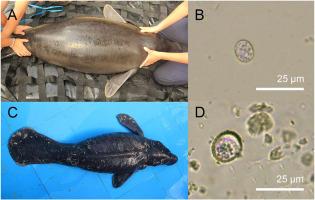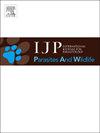Endoparasite survey in Amazonian manatees (Trichechus inunguis) under rehabilitation in the Peruvian Amazon
IF 2
3区 医学
Q3 ECOLOGY
International Journal for Parasitology-Parasites and Wildlife
Pub Date : 2024-10-28
DOI:10.1016/j.ijppaw.2024.101011
引用次数: 0
Abstract
Manatee populations are declining worldwide, and all currently existing species are considered vulnerable by the IUCN. The most common problems during nurturing young Amazonian manatees, Trichechus inunguis, in rescue centres are of gastrointestinal nature leading to inappetence, diarrhoea, cachexia and even death. Endoparasites play an important role in the well-being of wildlife in captivity as well as in the wild, though information about relevant protozoan and metazoan endoparasites in Amazonian manatees is still scarce. Therefore, this study aimed to find endoparasites in T. inunguis by analyzing faecal samples from 23 Amazonian manatees which were kept in rescue centres in the Peruvian Amazon. The samples were screened for protozoan and metazoan parasites using coproscopical analysis and molecular tools. Out of twenty juvenile animals eleven were positive for at least one Eimeriidae. Two morphologically different, not yet genetically described Eimeria species were identified. One of them seems to be Eimeria trichechi which has only been described once in 1984 in Amazonian manatees from Brazil. It was not found to lead to clinical symptoms of coccidiosis in this study. The second, Eimeria sp. Type B was associated with clinical coccidiosis in a young Amazonian manatee, which showed gastrointestinal symptoms including diarrhoea, inappetence and cachexia. No other protozoan or metazoan parasite were detected in any of the samples. The present study is the first to investigate endoparasites in Amazonian manatees using molecular tools and is the first to identify an Eimeria species that could be associated with clinical symptoms in T. inunguis. With information from our study rescue centres can improve monitoring of parasites more effectively to reduce morbidity and mortality rates among rehabilitated manatees as well as improve the health status and fitness of animals for a successful release back into the wild.

秘鲁亚马逊河流域正在恢复的亚马逊海牛(Trichechus inunguis)体内寄生虫调查
海牛的数量在全球范围内不断减少,世界自然保护联盟(IUCN)认为目前存在的所有物种都很脆弱。救助中心在哺育亚马逊海牛(Trichechus inunguis)幼崽时最常见的问题是肠胃问题,导致食欲不振、腹泻、恶病质甚至死亡。尽管有关亚马逊海牛体内原生动物和变态动物内寄生虫的信息仍然很少,但内寄生虫对圈养和野外野生动物的健康起着重要作用。因此,本研究旨在通过分析 23 只亚马逊海牛的粪便样本来发现海牛体内的内寄生虫,这些海牛被饲养在秘鲁亚马逊地区的救助中心。利用共显微镜分析和分子工具对样本进行了原生动物和后生动物寄生虫筛查。在 20 只幼年动物中,有 11 只至少对一种 Eimeriidae 寄生虫呈阳性反应。确定了两种形态不同、尚未在遗传学上描述过的艾美拉虫。其中一种似乎是Eimeria trichechi,仅于1984年在巴西亚马逊海牛中描述过一次。在这项研究中,没有发现它导致球虫病的临床症状。第二种是 B 型 Eimeria sp.,它与一只亚马逊海牛的临床球虫病有关,该海牛表现出腹泻、食欲不振和恶病质等胃肠道症状。在任何样本中都没有检测到其他原生动物或元虫寄生虫。本研究是首次利用分子工具调查亚马逊海牛体内寄生虫的研究,也是首次发现可能与海牛临床症状有关的艾美拉虫。根据我们的研究信息,救援中心可以更有效地改善对寄生虫的监测,以降低康复海牛的发病率和死亡率,并改善动物的健康状况和体能,以便成功地将其放归野外。
本文章由计算机程序翻译,如有差异,请以英文原文为准。
求助全文
约1分钟内获得全文
求助全文
来源期刊

International Journal for Parasitology-Parasites and Wildlife
Medicine-Infectious Diseases
CiteScore
3.80
自引率
5.60%
发文量
113
审稿时长
45 days
期刊介绍:
The International Journal for Parasitology: Parasites and Wildlife (IJP-PAW) publishes the results of original research on parasites of all wildlife, invertebrate and vertebrate. This includes free-ranging, wild populations, as well as captive wildlife, semi-domesticated species (e.g. reindeer) and farmed populations of recently domesticated or wild-captured species (e.g. cultured fishes). Articles on all aspects of wildlife parasitology are welcomed including taxonomy, biodiversity and distribution, ecology and epidemiology, population biology and host-parasite relationships. The impact of parasites on the health and conservation of wildlife is seen as an important area covered by the journal especially the potential role of environmental factors, for example climate. Also important to the journal is ''one health'' and the nature of interactions between wildlife, people and domestic animals, including disease emergence and zoonoses.
 求助内容:
求助内容: 应助结果提醒方式:
应助结果提醒方式:


